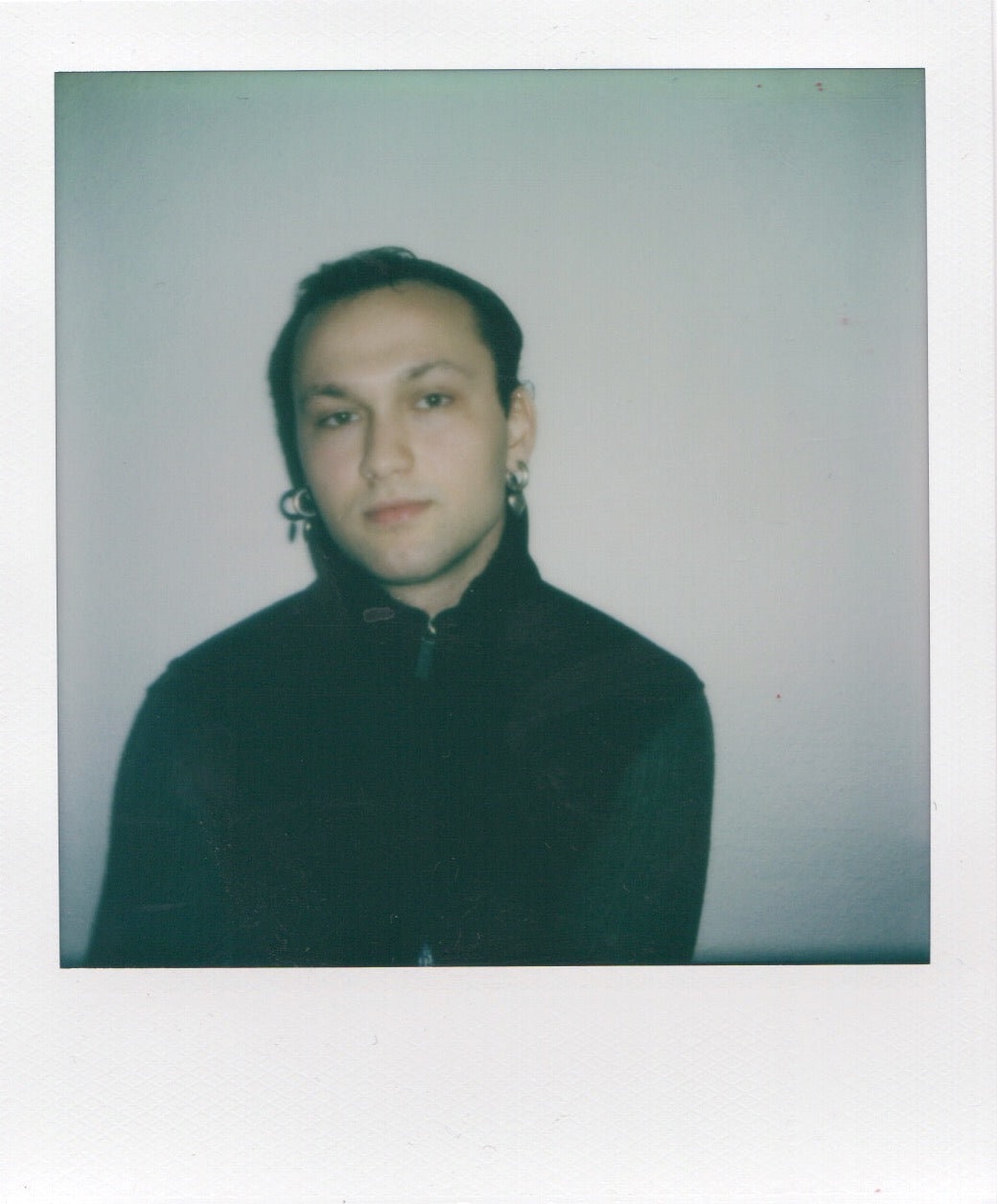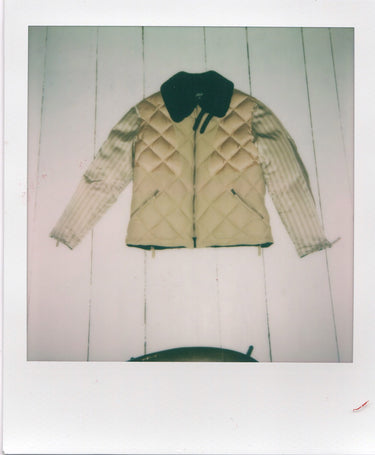Voo Visits
Voo Visits: Leon Teke
- Words
- Marie Wez
- Photography
- Javier de la Blanca

Voo Visits

For this episode we visit Leon Teke, the man behind the archive and instagram-only vintage shop CopMeIfYouCan. Self-taught and fashion-obsessed in the best way, he has grown a small business from his home in Berlin-Kreuzberg, providing his audience with a premium selection of vintage designer pieces.
We spoke to Leon about the origins of his obsession with vintage, the thrill of collecting and what it means to run a business from home.

V: Tell us about the origins of CopMeIfYouCan. How did you start collecting?
L: I have thrifted most of my wardrobe ever since my early teens. Playing around with what I had at hand and experimenting with my looks really made me develop a love for fashion. Buying vintage and archive clothes taught me what quality looks like in a garment - which cuts and seams are the most long-lasting, what material falls nicely.
CopMeIfYouCan came to life while I was abroad for an Erasmus Semester in Bologna, Italy. I went thrifting so much that I started buying things for my friends at home. Soon after, I began selling small quantities on my Instagram stories. Eventually all of this escalated into creating a new account and birthing my shop. I picked ‘CopMeIfYouCan’ as a reference to this one rather famous movie with a similar name, I just feel like it rolls off the tongue nicely. It was a three-second decision, it made sense to me.

V: Where does the interest for vintage and archival fashion stem from?
L: I’ve always been a gatherer, I started collecting things from a very young age. Marbles, Pokémon cards, stamps - I’ve done it all. Archive fashion just happened to be the next thing I fell in love with. The interest in archive is fueled by an obsession to assemble all parts of a puzzle, well-knowing that I can never achieve that in my life time. It’s a unique thrill to spot a cut that I know I’ve seen before, source a print I recognise or to a find missing counter part to something in my collection, uniting a set that has been long divided. It fulfills me to dig up references, do extensive research and find out as much as I can about a garment, about its moment in history and the specific context it comes with.
I believe this is something really unique about archival fashion and it’s fascinating to see how a lot of the topics that have influenced designers at the time are still relevant, still being referenced and rediscussed.

V: What’s your background, have you worked in Fashion before CMIYC?
L: After high school I went straight to uni to study psychology. Everything fashion related is self-taught. I remember struggling with the vocabulary so much in the beginning, I still sometimes do. There are so many wonderful words for every type of pleating, knit, fabric manipulation. And don’t even get me started on the topic of sizing. Why is there so many different scales?
I would love to continue working in fashion, I don’t think psychology is really the field for me. Continuously expanding CMIYC but also dabbling in other fields here and there. I always loved photography and was thinking of maybe interning for a fashion magazine next year if I find the time.
V: What’s your favourite piece ever sourced?
L: You are asking me to choose the favourite amongst my children? I am a huge fan of Jean Paul Gaultier Homme, especially the outerwear. If I have to choose I’d pick the quilted puffer jacket from Winter 2003, the one with striped sleeves that look like the silk lining of a Blazer. I sourced it in two color ways, the peachy one I will never let go of but the black and green version will be available at Voo Archive now. It’s the perfect piece, the cut, the choice of materials, zipper and button placements are all spot on. Sometimes I just sit and look at it for a little dose of serotonin.
V: CopMeIfYouCan has a very distinctive selection that obviously also mirrors your personal aesthetic. Are there any eras you’re particularly drawn to?
L: I can’t get enough of the late 1980s. Something post-punk maybe a little gothic influenced. I love the strong silhouettes, the bright colours but also the appreciation for a good black boot, which also aligned with my personal style. Short upper body, long legs, wider shoulder - absolutely obsessed. The Junior Gaultier line was dominantly produced in the late 80s and early 90s and is one of my favourite labels to source.
It’s comfortable, they made a lot of different types of bomber jackets and worked with silver hardware, a lot of sex-appeal. It was the time of short skirts and shiny fabrics, but in a non-overwhelming way, if that makes sense. It was an era of non-serious fashion, completely unpractical pieces combined with the the comfiest utility wear. I resonate with that.


V: How do you choose the pieces you collect and/or re-sell. Can you walk us through the process?
L: When making the selection for my shop it really comes down to detail. A piece has to feel right, make me want to look at it again and again to see more, know what it’s about. I love acquiring pieces that fit in with items I already have or had, but I don’t like buying the same thing twice.
When it comes to collecting, my focus is on Jean Paul Gaultier. The core collection then influences the pieces I collect around that. I have an obsession with tops and jackets and a hard time with pants, but love a good skirt or dress. In essence, I try to curate a selection that you have to come to me for, consisting of pieces that you can’t just find a second time. The moment a collection is trending, I try to move on to other shows that spark my interest and to colours and cuts that are not on everyone’s wish list. I learned that this is what bring me sanity, what allows me to be most at peace with my selection.

V: What do you think about the current state of fashion and what role does vintage play in it?
L: I am actually quite optimistic about the current state of fashion, maybe even naively. But I believe that we have an ever-growing consciousness for our current consumption patterns. The influence of vintage on the industry is undeniable, even though it also leads to fashion fashion companies green-washing, trying to copy the “vintage look”, whatever that may be.
I’m witnessing a trend with many big fashion houses returning to their house codes and own history, releasing re-editions or even a curation of in-house vintage selections.
Quite clearly our thirst for individuality and sustainability is having somewhat of a positive impact and archival fashion can satisfy the need for both.
I don’t necessarily think people make sustainable choices because they are good for others or the environment but because they see the benefit for themselves. The vintage industry is fashion’s good-hair-day, it’s sustainable luxury, it’s sharable and it’s incredibly presentable. Fashion is still one of the most harmful and manipulative industries, but a lot of work is being done, education and awareness is trendy. A lot of people are collectively changing the industry from within and I am proud to be a part of that.
V: What do you wish people knew about vintage?
L: There’s no limit to it, its not gonna run out tomorrow. The amount of clothing that has been produced over the last couple of decades is enough to supply us all. The quality is inherently higher in comparison to a similar new product today. I learned, that for example the fiber length of cotton has been on a decline since the early 90s. The more we produce and the quicker we need it to grow, the lower the quality becomes. So it makes sense to treat yourself to vintage garments. They might already be 20 years old but they will quite possibly last longer than their contemporary counter part.

V: What’s a moment in fashion that has shaped you?
L: Coco Rocha opening the Jean Paul Gaultier runway in Winter 2007. She was not walking, the woman was gliding down the runway performing a Celtic dance. Excuse me, but how iconic is that? Please watch the video and you’ll understand the fundamental impact this had on me.
V: Your home is also your studio/storage. How do you navigate waking up in vintage heaven while still achieving a somewhat healthy work/life balance?
L: It’s wonderful on one hand but quite exhausting on the other. Vintage heaven is my work place and in order to maintain a healthy relationship with it, I have to set clear boundaries. I keep my desk and CMIYC stock separate from the rest of my space. I appreciate the limit this work set-up gives me, I need a bit of restriction when it comes to storage space. Knowing everything I buy has to fit on these two racks and I’ll have it right in front of me every day really makes me consider every piece I buy carefully. Special shout-out to my flatmates and besties who have to bare with me running a business from home.
Still, it’s a blessing to be surrounded by such beautiful garments and I love having them around me. And if sometimes that means falling from my bed straight to my desk, so be it.
Voo Archive will feature a curated selection of CopMeIfYouCan pieces from Tuesday, November 22nd in-store and online.
Find an exclusive preview here.
Voo Visits is a series introducing new and old friends of Voo, like-minded creatives and people from Berlin who inspire us.